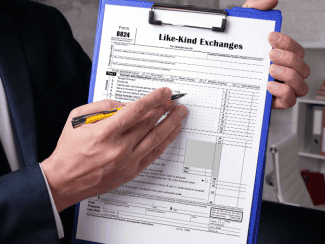Obstacles to Avoid for a Successful 1031 Exchange
Many investors decide that they want to structure their real estate transactions as a 1031 Exchange, without knowing all of the steps and hurdles they can encounter along the way. But being well-informed before the sale of the first property is critical to the success of a1031 Exchange.
Here we will discuss some common obstacles people face in a 1031 Exchange, all of which can be avoided by planning early.
-
Not Using a Qualified Intermediary

-
Using a Disqualified Party as Your Qualified Intermediary
The Regulations define a Qualified Intermediary as a party who is not the taxpayer or a disqualified person, who by a series of assignments enters into an exchange agreement with the taxpayer and acts as the party to complete the exchange. A disqualified person includes anyone “who has acted as the taxpayer’s employee, attorney, accountant, investment banker or broker, or real estate agent or broker” within the preceding two years, as well as family members and other prohibited relationships. When the taxpayer utilizes the services of his attorney to be his Qualified Intermediary, for example, the attorney is disqualified from serving as the Qualified Intermediary, and the exchange would be disallowed.
-
Selecting the Wrong Qualified Intermediary
As in most other business settings, not all Qualified Intermediaries are created equal. At a minimum, we recommend selecting a Qualified Intermediary that is a member of the Federation of Exchange Accommodators (FEA), the only national association representing Qualified Intermediaries, and tax/legal advisors who are directly involved in the 1031 exchange industry. We also highly recommend selecting a Qualified Intermediary that has multiple Certified Exchange Specialists® (CES®) on staff. The CES® designation is the only independent, tested designation for 1031 exchange professionals. A Qualified Intermediary that has a team of attorneys on staff is also recommended, as not all exchanges are as routine as they may seem up front.
-
Not Hiring the Qualified Intermediary Before the Sale
As mentioned previously, the taxpayer may not have actual or constructive receipt of the exchange funds. Phrased another way, the 1031 exchange must be established and in place at or before the closing of the first property in the exchange. Vetting and selecting the Qualified Intermediary in advance of the closing is integral to a successful 1031 exchange.
-
Failing to Properly Document the Exchange
Some people believe that the sole purpose of the Qualified Intermediary (QI) is to hold the exchange funds. While this is certainly an important function of the Qualified Intermediary, it is not the main function of a QI. For a 1031 exchange to be valid, there must be an Exchange Agreement between the taxpayer and the Qualified Intermediary; the taxpayer must assign their rights in the sale and purchase contracts to the Qualified Intermediary; and the taxpayer must notify all other parties to the exchange of that assignment. The Qualified Intermediary prepares these documents and ensures proper notification to the other parties to the exchange.
-
Trying to Exchange Ineligible or Disqualified Property
Virtually every day we receive a phone call from someone who wishes to participate in a 1031 exchange involving vacation homes. Yet the statute is clear that the properties in the exchange must be “held for productive use in a trade or business, or for investment.” Under the Regulations, ‘disqualified property’ is property that was not held for productive use in a trade or business or for investment. Second homes, vacation homes, or other property that is used exclusively by the taxpayer for their own enjoyment, with no business or investment motive, are therefore not qualified property and not eligible for a 1031 Exchange.
-
Fix-and-Flip Properties
As noted above, the properties being exchanged must be “held for productive use in a trade or business or for investment.” Property that was acquired to be improved or rehabbed, and then immediately resold is viewed as inventory, rather than investment property. These so-called ‘fix-and-flip’ properties do not qualify as business or investment property, and are not allowed with a 1031 Exchange.
-
Not Exchanging Equal or Up in Value, and Equity
There is a common misconception that taxpayers only need to reinvest the gains or profits on the sale of their Relinquished Properties. Others are of the mistaken belief that they only need to reinvest the cash that was generated at the sale, after satisfying loans and paying closing costs. Both situations will result in the taxpayer being exposed to potential tax liabilities. Rather, taxpayers should endeavor to exchange equal or up in fair market value, and equal or up in equity, and to replace any debt from the Relinquished Property or properties within 180 calendar days after the closing on the Relinquished Property. Failure to comply with the identification rules effectively invalidates the 1031 Exchange.
-
Failing to Consider a Reverse Exchange
The IRS approved the concept of so-called “reverse exchanges” over twenty years ago. Yet many advisors and even more taxpayers are unaware of the concept, and the incredible power that they provide. When real estate markets are incredibly hot, many taxpayers are fearful that they will not be able to find quality Replacement Property within the identification period, or to complete the purchase within the exchange period. Enter the reverse exchange. With a reverse exchange, the taxpayer acquires the Replacement Property before the sale of the Relinquished Property. The process is a little more complicated, but in a situation where both the Relinquished and Replacement properties are rental properties generating cash, the taxpayer has the potential to double their cash flow during the exchange period.
-
Partnership Issues
Taxpayers often acquire properties together with other investors. When multiple investors pool their resources and acquire real estate inside of a limited liability company (LLC), that LLC is a entity – a taxpayer unto itself. The individual taxpayers do not have independent rights to perform 1031 exchanges, or not, beyond the confines of the LLC. If they wish to exchange independently of one another, they should plan for that well in advance of the sale of the property. Concepts to accomplish this include “drop and swap” and “swap and drop” are discussed in more detail here. They should consult with their tax and legal advisors, and plan carefully to maximize their compliance with 1031 Exchange rules, especially the concept of “held for investment.”
-
Settlement Statement Issues
Some settlement agents do not fully comprehend the significance of the Assignment (discussed in number 5, above) on the 1031 Exchange. The Assignment effectively inserts the Qualified Intermediary as the seller of the Relinquished Property and the buyer of the Replacement Property. It is by virtue of these assignments that the taxpayer ‘exchanges’ the Relinquished Property for the Replacement Property. Because the taxpayer has assigned their interests in the underlying real estate contract, the settlement statement should identify the seller of the Relinquished Property and the buyer of the Replacement Property as Qualified Intermediary’ for [taxpayer’ name]. Further, non-qualifying expenses would ideally be handled outside of closing and can be identified as ‘POC’ on the closing statement. Additionally, overfunding the purchase of the Replacement Property, resulting in cash flowing back to the taxpayer, could result in a taxable event for the taxpayer. Each line item on the Settlement Statement should be scrutinized by the taxpayer and their tax/legal advisors to ensure compliance with the 1031 Exchange rules.
As you can see, there are many opportunities for taxpayers to create headaches for themselves, or foot fault into non-compliance issues with a 1031 Exchange. As always, taxpayers are encouraged to discuss their plans with their tax and legal advisors before they embark on the path toward the sale of an investment or business use property, and to engage the services of a Qualified Intermediary before the first closing that will effectively start their 1031 Exchange.
Source: Real Estate Investing Today















 Accessibility
Accessibility